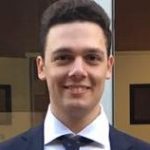 Francesco Castellucci, UGLAS
Francesco Castellucci, UGLAS
Phase coherent generation and storage of structured light in an atomic vapour
Layman’s Title: Storing images in cold atomic vapours
My activity in brief
“An image says more than a thousand words.” Images, and more generally structured light, can be used to overcome the current limitations in data capacity. It is now possible to structure the intensity, phase and polarisation profile of a light beam. In order to make this information useful for communication applications, however, we need to develop ways to store, manipulate and retrieve this information. In my project I aim to tackle this problem by providing an innovative scheme to “enscript” data encoded as structured light onto a cold atomic cloud.
The focus of the research
I work with atoms cooled down to temperatures close to absolute zero, so that they are almost stationary. These atoms are exposed to a light field with a locally varying structure, they therefore react differently, depending on their position within the light beam. I will encode information as a varying polarisation profile within a light beam, so that at different positions within the beam profile the electric field oscillates in different directions. This means that the optical information can be transferred to the electronic levels of the atoms. I will study this process, and in particular the importance of collective effects, in detail.
Networking opportunities
During my project I will collaborate with various groups of the ColOpt network; with researchers at the University Muenster on the generation of structured light; with the optics company HOLOEYE on polarization-dependent holographic diffraction; and with the University of Saarland and Strathclyde on the theoretical aspects of atomic data storage.
Outcomes and impact
I hope that my research will shed light on a new approach towards a flexible quantum communication system. On a fundamental level, we will gain a deeper understanding of how atoms respond to the full electromagnetic fields of structured light. This understanding will be crucial in order to develop technological application. As R. Feynman pointed out “Nature isn’t classical, dammit, and if you want to make a simulation of nature, you’d better make it quantum mechanical, and by golly it’s a wonderful problem, because it doesn’t look so easy.”
Biography: Francesco
Born in Cascia, Italy Francesco studied Physics at the University of Pisa, where he gained both his Bachelor’s and Master’s degrees. His field of study was Matter Physics, Statistical Physics and Atom Optics. In December 2016 he received my Master’s degree in Physics with a thesis on “Experimental signatures of an absorbing-state phase transition”. In June 2017 he joined the ColOpt network as an Early Stage Researcher at the University of Glasgow.